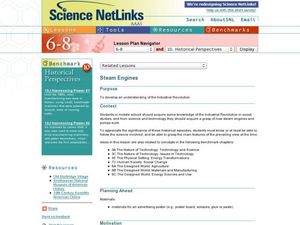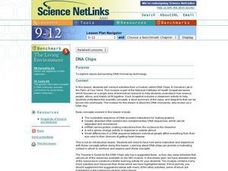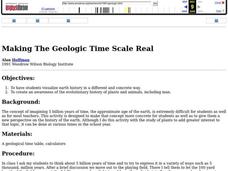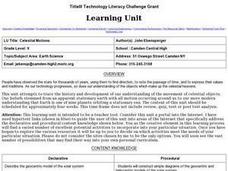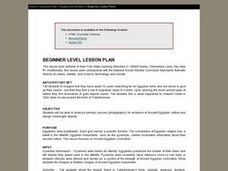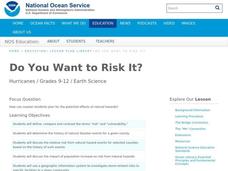Curated OER
Steam Engines
Students investigate the invention of the steam engine. In this technology lesson, students investigate the advancement of technology over time. They relate science and technology together.
Curated OER
Seeing Stars
Students explore the history of planetariums and the features of the Hayden Planetarium as a springboard to planning, developing and displaying their own planetarium exhibits.
Curated OER
DNA Chips
Students explore issues surrounding DNA microarray technology. They focus on a single area of biomedical research to help them explain how science, people, ethics, and history all fit together. They analyze gene-expression data.
Curated OER
A River Ran Through It
Students research how water is used to generate electricity. They investigate water's potential-to-kinetic energy transfer in hands-on activities about falling water and waterwheels. They take measurements, calculate averages and graph...
Curated OER
Cougar or Human: Which Needs Protection?
Students research the biology and natural history of the cougar. Students conduct Internet research to determine how cougars have been protected by humans and how it is affected by human decisions. Students write about reconciling...
Curated OER
Making The Geologic Time Scale Real
Students are assigned significant geologic events in Earth's history. They convert the date of the events into distances and then space themselves (on an outside playing field) away from other groups, to represent time between various...
Curated OER
The ABC's of Artifacts
Students create their own ABC book about artifacts. In this artifact lesson, students read ABC History Mystery and review the artifacts pictured in the book. They create their own ABC book with each student working on a letter.
Curated OER
Aztec Floating Gardens
Aztecs created amazing hydroponic gardens called Chinampas, to grow their crops. Learners in grades k-7 engage in four mini-experiments to understand just how amazing floating gardens are. Tip: A perfect way to bring science into your...
Curated OER
Celestial Motions
Ninth graders complete a unit of lessons on the history of our knowledge of celestial objects. They conduct Internet research, plot the motion of a planet, construct a model of the sun's apparent motions, and create diagrams of the solar...
Curated OER
Shapes and Shelters
Students are be able to analyze primary sources (photographs) for evidence of Ancient Egyptian culture and design meaningful objects. They are grouped in pairs and instructed to choose someone that they admire, either living or...
Curated OER
Planning A Railroad Online Lesson
Pupils plan a route across Donner Summit using topographical maps in order to understand the challenges involved in constructing the railroad in the Sierra Nevada Mountains. In this history lesson, students first discover how to read a...
Alabama Learning Exchange
This Is How We Roll!
Students research how roller coasters work. In this physics lesson, learners research the history of roller coasters and the safety factors in the design of a roller coaster on the website www.learner.org/exhibits/parkphysics. They...
Curated OER
Edible Coal Mining
Learners explore the concept of bituminous coal and the role it plays within our world. In this economic and earth science instructional activity, learners discover and model the extraction methods with hands-on activities. ...
Curated OER
Do You Want to Risk it?
Students investigate the history of natural disaster events for a given county, discuss the impact of population and the risk from natural disaster events. In this hurricane lesson students use a geographic information system to...
Curated OER
Hero Or Zero?
Students investigate science and technology by reading a children's book. In this reading comprehension lesson, students read the story Archibald Frisby and discuss the ways we use science and technology in everyday life....
Curated OER
The Golden Spike
Students investigate modern transportation in the 19th century by examining artifacts. In this U.S. history instructional activity, students read the story Joseph's Railroad Dreams, and discuss the Golden Spike used in the first...
Curated OER
Moving Objects
Learners discover the history of the United States by examining the Great Migration. In this U.S. History lesson, students research the immigration movement on the Internet and complete a worksheet about the large population...
Curated OER
Topic: Military/ Defense
Students examine ancient military systems. In this history of defense lesson, students research the weapons employed defending ancient cities and territories. Students describe how they would defend themselves following a plane wreck...
Curated OER
A Lucky Break
Students complete activities where they identify and decipher common phrases that are related to poultry and then cook drumsticks as a class. In this poultry lesson plan, students also read the history of the chicken and create idioms.
Curated OER
Reading Trees: Understanding Dendrochronology
Students examine tree-ring dating and discuss the lack of water the settlers in Jamestown faced. They create paper tree rings, simulate rain patterns, and describe the history of construction paper tree sequences.
Curated OER
Applied Evolution: How Will We Get There from Here?
Students explore the basic process of natural selection and how people can manipulate that process today. The consequences of natural selection on daily life and the implications of evolutionary biology in basic and applied science is...
Curated OER
Wushu Were Here
Young scholars create a fan-shaped story screen that explains 4 major points surrounding various facts, myths, expressions, or story elements in Chinese history, culture and/or literature.
Curated OER
Art and Anatomy: The Vitruvian Teen
Students are introduced to the history of showing the human anatomy. In groups, they measure their height and arm spans to create a graph and determine if their measurements support Vitruvius' work. Individually, they make their own...
Curated OER
Launches for the Stars
Students are introduced to rockets and the space shuttle program. After viewing a 1960s show, they examine the role and history of NASA and how it evolved into having a space shuttle program. In groups, they create their own model rocket...
Other popular searches
- History of Science
- History of Science Museums
- The History of Science
- History of Science Nuclear
- History of Science Physics
- History of Science Georges
- History and Nature of Science
- History and Social Science
- History Social Science
- Ancient Science Inventions
- History and Science Fiction
- History of Forensic Science


